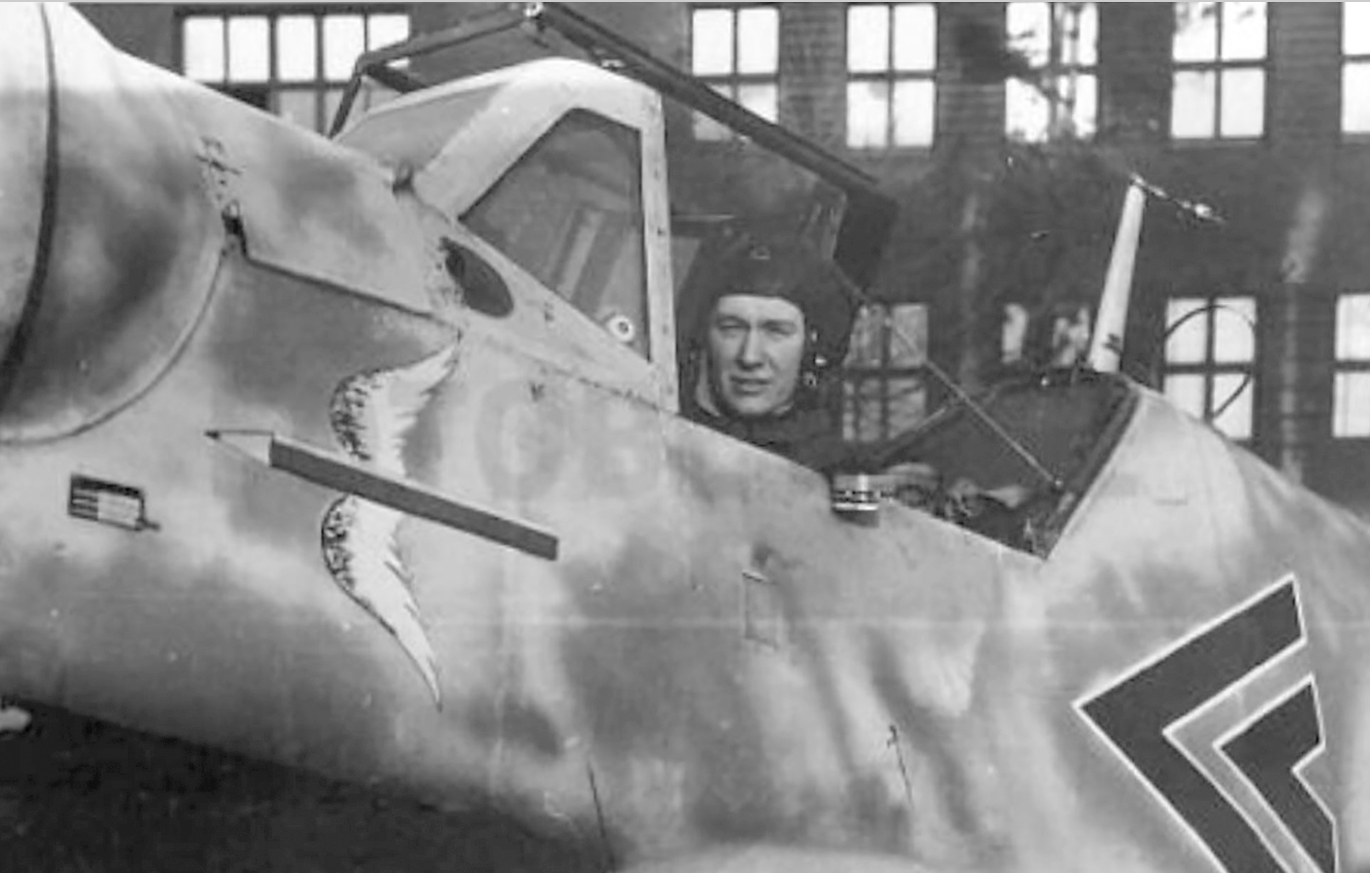Günther Specht was a distinguished German fighter pilot during World War II, credited with a significant number of aerial victories. Born in 1914, Specht joined the Luftwaffe in 1936, demonstrating an impressive aptitude for flying, which saw him quickly rising through the ranks. In the course of the conflict, he flew over 500 missions, reportedly shooting down 34 enemy aircraft, earning him the status of ‘flying ace.’ His courage and skill were recognized with numerous military honors, including the Knight’s Cross of the Iron Cross.
Despite his success in the air, Specht’s career was marred by several accidents. In 1945, he severely injured himself while attempting to bail out of a burning aircraft. After the war, Specht devoted his life to the development of aviation technology. His expertise was instrumental in the advancement of German post-war aviation, notably in the field of jet propulsion. Günther Specht’s story is one of dedication, skill, and bravery, marking him as one of the most significant figures in the annals of German aviation history.

Personal Traits and Characteristics
Personal traits and characteristics form the unique blueprint of an individual’s personality, shaping who they are and how they interact with the world around them. These attributes can be innate or developed over time due to environmental influences. They encompass a vast range of aspects such as confidence, resilience, empathy, honesty, and creativity. Some people may possess a naturally outgoing or extroverted nature, while others may be more introverted and prefer solitary activities. Traits like honesty and integrity play an influential role in how a person behaves in different situations and how others perceive them. Similarly, characteristics such as resilience and adaptability can determine how well an individual copes with challenges, changes, and setbacks. Meanwhile, traits like empathy and kindness influence how one relates to and treats others.
Moreover, these traits and characteristics are not set in stone; they can be refined or changed over time through personal growth and experiences. For instance, a person can cultivate patience through mindfulness exercises or develop confidence by stepping out of their comfort zone. Understanding one’s personal traits and characteristics is an essential part of self-awareness. It provides valuable insights into one’s strengths and areas for improvement, ultimately guiding personal development and growth.
Furthermore, personal traits and characteristics also play a crucial role in shaping one’s career and relationships. Certain professions might require specific traits, such as creativity in an artist or decisiveness in a leader. On the other hand, qualities like understanding and compassion are vital in maintaining healthy relationships. Therefore, personal traits and characteristics are not just aspects of our identity but also key determinants of our interactions with others and our overall journey in life.
Military Career and Notable Achievements
A military career is a path laden with discipline, commitment, and an unwavering sense of duty towards one’s nation. The individuals who choose this path dedicate their lives to the protection and service of their homeland. The journey is fraught with demanding physical and psychological challenges, demanding training regimens, and tough assignments, often in the harshest conditions. However, it’s this relentless dedication and resilience that make military personnel stand out among their peers, thereby resulting in notable achievements in their career.
One of the hallmarks of a military career is the progression through various ranks, each representing increased responsibility and leadership. This progression is a testament to the individual’s professional growth, strategic acumen, and leadership skills. For instance, the ascension to high-ranking positions such as a General or Admiral, is a notable achievement that reflects their perseverance, strategic thinking, and the respect they command among their peers and subordinates.
Moreover, military careers often present opportunities to contribute significantly during times of conflict or crisis. This could be in the form of successful strategic operations, rescuing civilians in war zones, or humanitarian missions during natural disasters. Such accomplishments not only earn them commendations and medals but also the gratitude and respect of their fellow citizens.
Military personnel may also find themselves contributing to the development of military technology, policies, and strategies that shape the future of defense procedures globally. Their expertise and experience can lead to advancements that significantly enhance the operational efficiency and effectiveness of the military.
In conclusion, a military career, while challenging and demanding, offers opportunities for noteworthy achievements that extend beyond personal growth. These achievements often have far-reaching implications, impacting the lives of many and shaping the course of a nation’s history. It’s a career that demands sacrifice and resilience, but the rewards, in terms of honor, respect, and the opportunity to make a real difference, are unparalleled.

Operation Bodenplatte: Role and Impact
Operation Bodenplatte was a significant military campaign during the latter stages of World War II, carried out by the German Luftwaffe. Conducted on January 1, 1945, this operation aimed to gain air superiority during the stagnant phase of the Battle of the Bulge. The Luftwaffe intended to destroy a substantial portion of the Allied air forces on the ground, thus tilting the balance of the air war in favor of Germany. However, the operation failed to achieve its primary objectives, resulting in a significant loss of aircraft and experienced pilots for the Germans.
The role of Operation Bodenplatte was primarily to reduce the air power of the Allies, thereby alleviating the pressure on German ground forces. It was hoped that this action would facilitate a successful counter-offensive and strengthen the German position on the Western front. The operation involved more than 800 German aircraft targeting 16 Allied airfields in Belgium, the Netherlands, and France.
The impact of Operation Bodenplatte was substantial, though not in the way the Germans had intended. While the operation caused heavy losses to the Allied forces, with over 300 aircraft destroyed, the German Luftwaffe suffered even greater losses. More than 200 German aircraft were destroyed, and many experienced pilots were lost, which was a substantial blow to the already depleted Luftwaffe resources. Furthermore, the operation did not significantly disrupt the Allied air operations as anticipated. Instead, it led to an acceleration of the Allied advance into Germany.
In hindsight, Operation Bodenplatte is considered a desperate attempt by the German High Command to regain the initiative in a war that was increasingly slipping away from their grasp. Despite inflicting considerable damage, the operation ultimately failed in its main objectives and accelerated the decline of the Luftwaffe. Its execution marked one of the last major offensives by the German Air Force during World War II, symbolizing the imminent downfall of the Third Reich.
Overview of Career and Contributions
Career and contributions are two interconnected topics that carry immense importance in an individual’s professional journey. A career, in the broadest term, refers to the progression and actions one takes in their professional life. It spans from initial learning and education, through different stages of work, possibly encompassing multiple roles and organizations. It could be within a single industry or could spread across different fields, shaped by an individual’s skills, interests, and ambitions. The contributions, on the other hand, refer to the impact a person makes within their chosen career path. This impact can take multiple forms, such as influencing industry trends, advancements in a specific field, mentoring others, or even creating a whole new area of expertise.
The scale of these contributions can be local, regional, or global, and their significance can be measured in various ways, including recognition by peers, awards, and the lasting effects of their work. The quality and quantity of these contributions are often a result of the individual’s dedication, skill set, and the opportunities they encounter throughout their career. Both career and contributions are dynamic, influenced by external factors like market trends, societal needs, and technological advancements, as well as internal factors like personal growth, learning, and adaptability. Thus, an overview of career and contributions paints a picture of a person’s professional journey, the impact they’ve made, and the legacy they leave behind.
Dates of Rank and Promotions
Dates of rank and promotions are significant aspects of any military or paramilitary organization, signifying the ascension of an individual to a higher level of responsibility and authority. These dates are meticulously recorded and adhered to, as they not only reflect an individual’s progression within the ranks, but also determine their authority level, seniority, and eligibility for additional promotions.
Promotions are guided by a standardized process and criteria that may include factors such as the individual’s length of service, performance evaluations, and the needs of the organization. These promotions may be to a higher pay grade, a position of greater responsibility, or to a distinct classification of rank. There are typically set intervals between promotions, ensuring that each individual has an appropriate amount of time to acquire the necessary skills and experience at their current level before advancing.
The date of rank, on the other hand, is the official recognition of an individual’s new status. It is the day on which a promotion takes effect, and from which point the individual is considered to hold their new rank. The date of rank can impact an individual’s standing within their organization, their pay, and their retirement benefits. It also plays a crucial role in determining the order of precedence during instances of simultaneous promotions.
Notably, the system of promotions and date of rank is not limited to military organizations alone. It is also applicable in corporate settings, academia, and other professional environments where a hierarchical structure exists. Regardless of the context, the processes involved in promotions and determining dates of rank require meticulous attention to detail and a commitment to fairness and transparency. This ensures that every individual’s contributions are recognized and rewarded appropriately, fostering a culture of meritocracy and respect.
